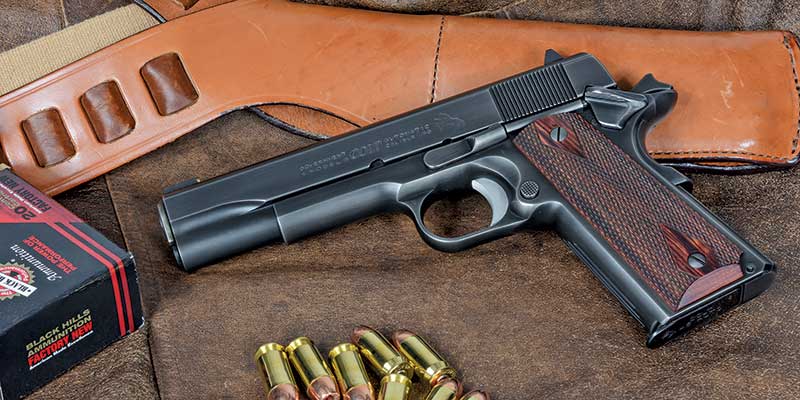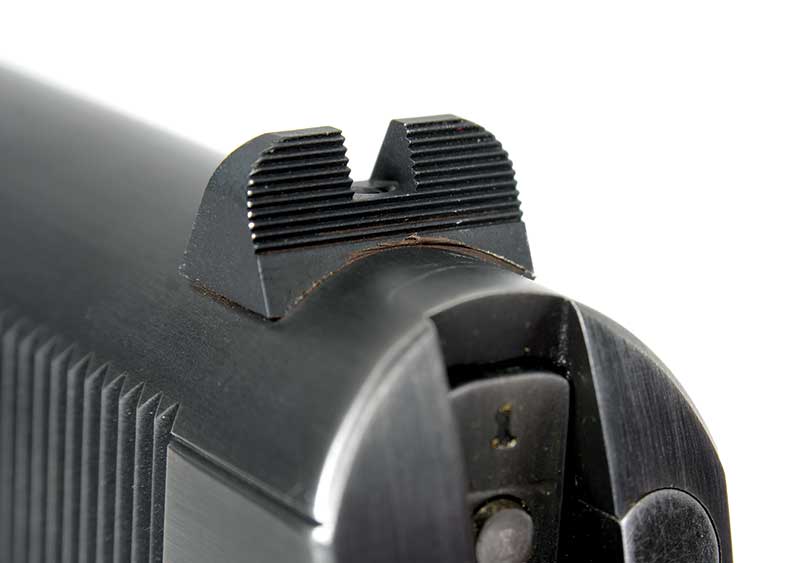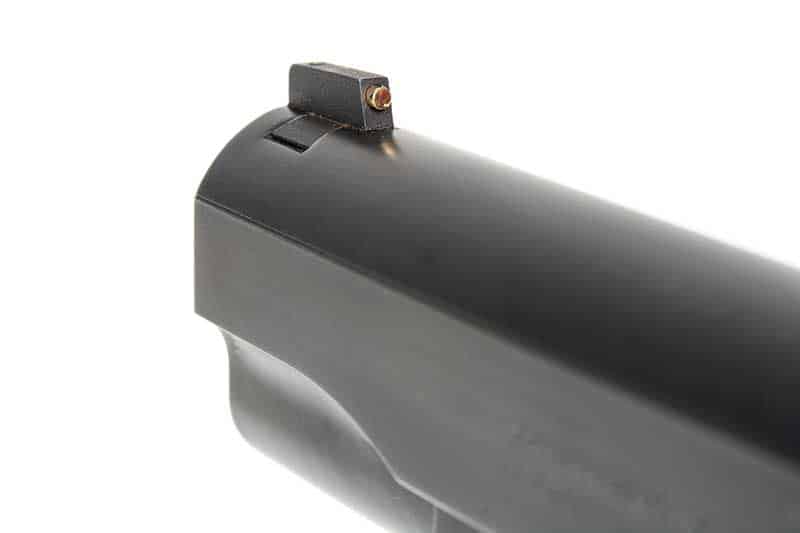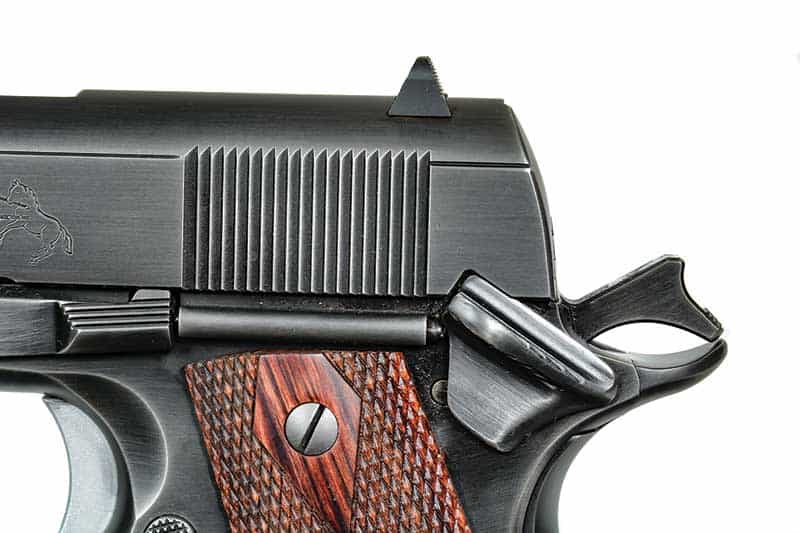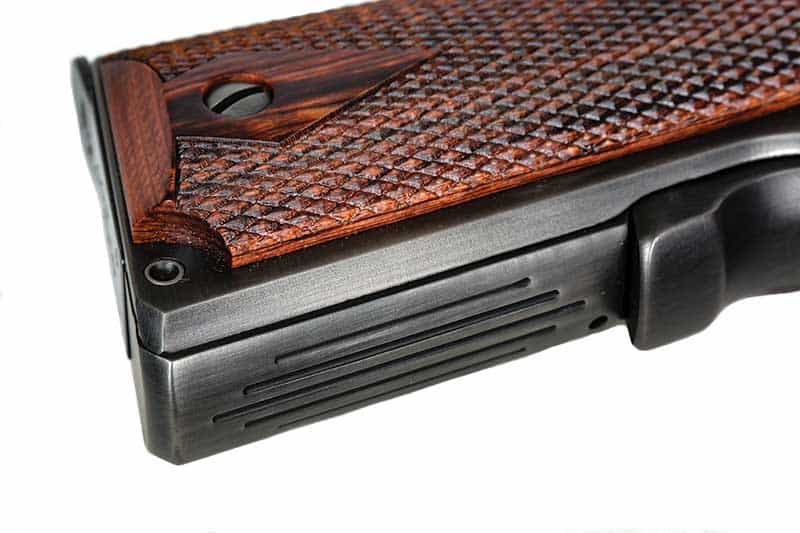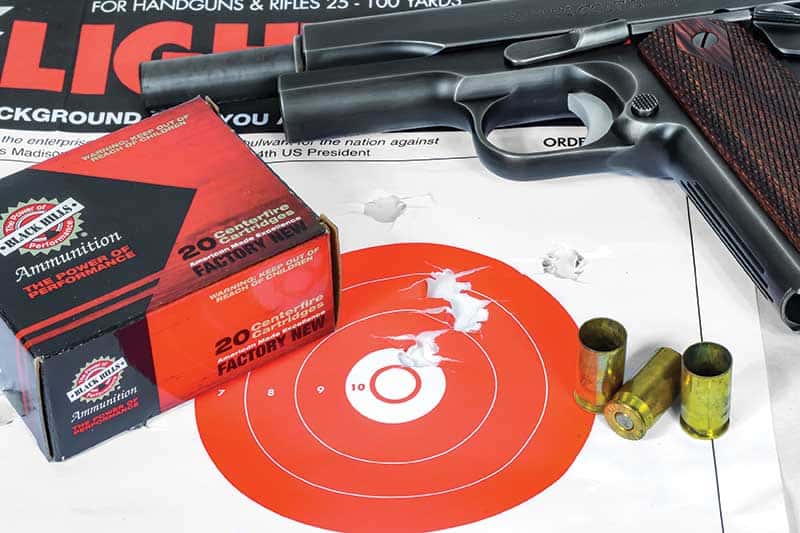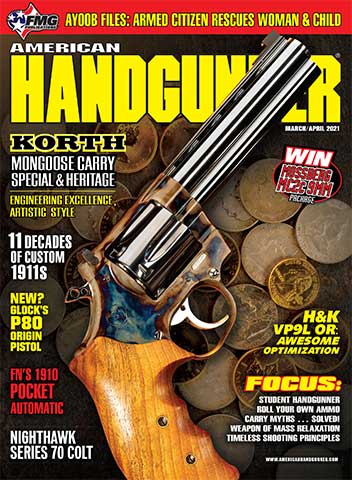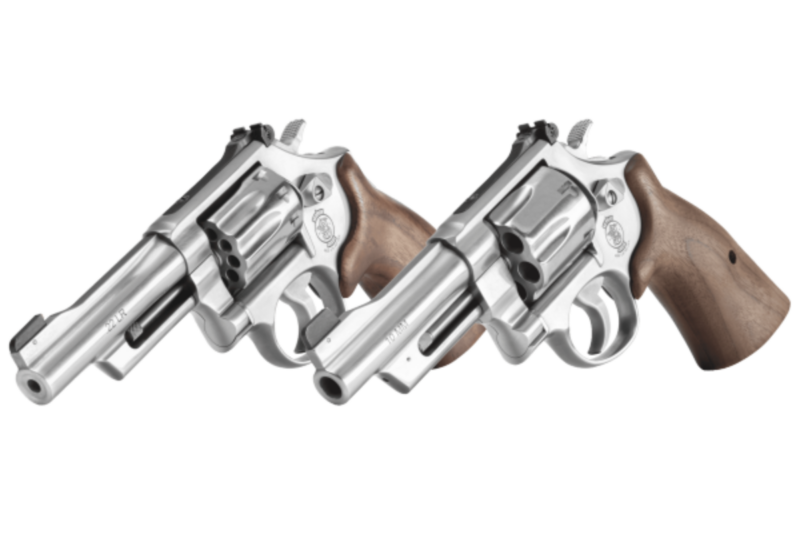A Light Touch
Nighthawk's Series 70 Colt
We’ve grown so accustomed to seeing Nighthawk turn out finished guns built in- house most people don’t realize it also offers gunsmithing services on pistols manufactured elsewhere. This includes their Series 70 Colt Government Model, a retro .45 with a distinctive smoked nitride finish.
Detail Work
Sometimes the lightest touch is the best, and in this era, where a custom pistol means things like cocking serrations machined to look like a primitive circuit board, a little simplicity is refreshing. For starters, the gun begins life as a Series 70 Colt Government Model, which eliminates the sometimes-controversial Series 80 passive firing pin safety that some users say spoils the trigger pull on an M1911. Personally, I have no problem with it: Coupled with a captive half cock hammer, it’s about as safe as a M1911 can get. My Series 80 guns have excellent triggers. At the same time, adding parts to John Browning’s design invites trouble, and the trend has long been back toward the basic action of the Series 70.
The sights consist of a dovetail front with a gold bead, while the rear sight is a high-profile fixed sight from Harrison Design. Similar in profile to the basic M1911A1 rear sight, the Harrison is taller and has a serrated rear face to cut glare, along with a broad notch to give plenty of light for the front post, and is held in place with a hex screw located in the bottom of the sight notch. The original old school night sight, a gold bead, tends to collect available light, drawing your eye to the front sight. Using actual gold means it never tarnishes. It’s a favorite of mine and several of my carry guns have Novak’s gold bead front sights installed.
Smooth
All the sharp edges have been removed from the gun that sports the traditional vertical cocking serrations, and the ejection port is not flared. A single accent line is machined down the side of the slide where the flat meets the rounded top: Not technically a French border as it is often called (that usually has a second outline within the lines of the slide), it’s still an elegant touch. While the pistol retains the stock Colt barrel, it has been throated and polished to ensure maximum reliability and mated with a match barrel bushing.
The shortened spur hammer is paired with machined internal lockwork and a short aluminum trigger, all provided by Nighthawk, and the combination creates an excellent, crisp trigger pull that broke cleanly at 3 lbs., 11 oz., as measured on my Lyman digital trigger pull gauge.
Recoil Ergonomics
Unlike the usual upswept grip safety we’re all used to, this beavertail barely protrudes beyond the tip of the hammer spur, which, candidly, is probably short enough to eliminate hammer bite for most shooters. That does not, however, make the beavertail unnecessary: one of its main purposes is to spread out recoil across the web of the hand, which is a bigger deal than you think, as a gun with the narrow rat tail safety can be so unpleasant to shoot that it actually feels like hammer bite, even when it isn’t. The other controls — safety, slide stop, magazine release — are all standard Colt parts tuned to the individual gun. While many of us are used to extended thumb safeties, there’s nothing wrong with the original one, and I had no problem operating it.
The top of the frontstrap has been modified where it meets the trigger guard, an important ergonomic touch that lets the gun sit lower in the hand, which helps reduce felt recoil. Both it and the flat mainspring housing have received vertical serrations to help add purchase. In all candor, the ball mill cut serrations look a little anachronistic on a retro gun — the narrow serrations usually cut with a slitting saw would look more period correct — but they do help add texture to the gun without being as aggressive and abrasive as checkering. For those of us who have ruined many jackets and shirts with checkered .45s, that’s appreciated.
A Looker
Grips are the traditional double-diamond checkered wood and the magazine well has been mildly beveled to help speed reloads. The entire package is finished in what Nighthawk calls a smoked nitride. I will be the first to admit that I know little about smoke — its effects on meat are of most compelling interest to me — and even less about nitride, but have mercy, what a finish. As a general principle, I am no fan of pre-worn finishes. The scuffs and wear marks you put on a gun tell your story, and buying one artificially worn is a bit like paying someone to forge your signature. That said, the grayish, silvering color is quite attractive, and is the most striking feature about the gun; with the light touch used to modify this Colt, you’ll probably notice the finish before any of the other features.
Range Science
In my experience with Nighthawk pistols — of which about 10 have passed through my hands — they usually come out of the box, make it through my standard 500-round test without cleaning, oiling, or malfunctioning, and they average 2″ at 25 yards from the Ransom Rest, with the last couple guns shooting increasingly tighter average groups.
As per my usual, I put about 500 rounds through the Colt. I usually fire a mix of ball and jacketed hollowpoints when testing, but I ran a more eclectic array this time … something we’ll probably all be doing soon. This included ASYM’s 185-grain match JHP (which my Wiley Clapp Commander loves), 135-grain HoneyBadger from Black Hills, as well as conventional JHPs from them in 185-, 230- and 230-grain +P, as well as their 200-grain lead SWC.
Load Up supplied loaded ammunition using David Lauck’s (D&L Sports) service pistol bullet. In keeping with modern bullet design, where the performance results from the outside of the bullet as opposed to the shape of the cavity inside a hollowpoint, it’s essentially a 200-grain SWC redesigned to feed in autos. It comes in two profiles: one for revolver use and one for autos. In addition to trying both versions of the loaded ammo, I loaded a couple hundred rounds using the revolver bullet. The final load used was Double Tap’s +P 255-grain SWC, a massive hard cast lead slug that moves out around 875 fps. It’s an unusual load, more akin to a .45 Colt, but one I like a lot for its sheer momentum and which would be useful for predator defense where penetration carries the day.
All that said, sometimes you’re testing the gun and sometimes you’re testing the bullet, and this is a bit of both. The Nighthawk Colt ran flawlessly with conventional ammunition — that is, all the hollowpoints — as well as the HoneyBadger. It did, however, have a couple misfeeds with the revolver bullet, although it digested some 200 rounds of the same load without incident. Similarly, there were a couple misfeeds with the 200-grain SWC, and the +P 255-grain SWC caused a couple cases of premature slide lock, a common problem with uncommonly potent loads, which the 255 certainly is.
Government Model pistols, since they are expected to function with everything a shooter might grab off the shelf, from light 185-grain target loads to full power hardball, come with a 16-lb. recoil spring. Nighthawk upgraded this one to 17 lbs., and the gun had no spring related issues with anything other than the 255-grain +P: everything else, from 135- to 230-grain +P did fine. Moral of the story? Either stay within the usual power range or swap in a stronger recoil spring, such as the 18.5 I usually put in my guns.
So how did it actually shoot? Very, very well. The sights gave a good, distinct sight picture and the excellent trigger made it easy to get off a good, clean shot. While I did not do a formal Ransom Rest test with it, I was able to fire a best group of 2″ at 25 yards, standing and firing unsupported from a modified Weaver, which leads me to believe this gun is right in the accuracy range I expect from Nighthawk pistols, even though it still has its factory Colt barrel.
Sometimes more is more, but sometimes less gets it done, too. Machined from forged steel, unlike many of the other M1911 pistols, Colts are still excellent guns, and the carefully selected modifications Nighthawk has added make this one even better.
For more info: NighthawkCustom.com, Black-Hills.com, DLSports.com, DoubletapAmmo.com.

